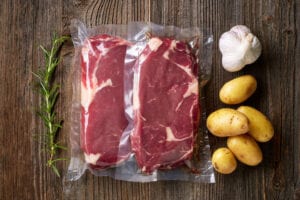Everything You Need to Know About Using a Vacuum Sealer for Food Prep

- June 5, 2018
The economy isn’t always kind to foodservice operations. It seems as if there are labor shortages, unexpected tariffs and unanticipated costs around every corner. Vacuum sealers may be the answer to help chefs and operators save valuable time and money, but a new piece of equipment can be a little daunting at first. Here’s what you need to know about preparing foods in bulk using a vacuum sealer.
Benefits of vacuum sealing
Oxidization is what causes foods to spoil more quickly. Vacuum sealers work to remove 99 percent of the oxygen from the food, stopping that oxidization process in its tracks. With nearly no oxygen in the seal, your food’s shelf life is extended dramatically. Industry research has found that vacuum sealing and blast chilling foods can add three to 12 days of shelf life, depending on the food — and that’s just in the refrigerator. If you vacuum seal and rapid freeze your food, it can be in the freezer for as long as you need without fear of crystals or freezer burn.
What to seal
It’s typical to cook and prepare foods, vacuum seal them and then put them in the cooler or freezer. But remember that vacuum sealers hold foods at any point in their oxidization process, so you can vacuum seal fresh produce straight off the truck, locking in their freshness. Think outside the box with how vacuum sealing can extend shelf lives, especially in industries with unpredictable natures, such as healthcare or education.
Sealing techniques
As far as we know, any piece of food can be vacuum sealed if it’s done properly. That said, not all food should be sealed the same way. Delicate foods, such as pastas, fruits or vegetables, will require what’s called a “soft seal,” while more resilient foods, such as chicken or steak, will only need a “hard seal.” Both seals remove the same amount of oxygen from the bag, but a soft seal will take longer to process. In the instance of a soft seal, the suction is intermittent, with several seconds of sucking followed by several seconds of rest in order to preserve the delicate nature of the food. With a hard seal, the oxygen is sucked out in one instance with no breaks. These seal techniques can be programmed into an industrial vacuum sealer to ensure that food is safely vacuumed every time.
Pairing with sous vide cooking
Vacuum sealers and sous vide cooking go together like macaroni and cheese. For sous vide cooking, much of your prep can be done in advance if you have a good idea of what you’ll need for the day. The sous vide method will hold foods at specific temperatures, allowing you to preserve food consistency while allowing kitchen staff to focus on other tasks.
Getting advice
Any piece of new equipment can be a little daunting until you understand it. With a ThermalRite vacuum sealer, you receive the full Everidge brand promise of service every step of the way. We’re available for recommendations and advice, even if your questions don’t come until a year or two after your purchase, because we stand by our brand.
Interested in a ThermalRite vacuum sealer? Learn more about the product.










